I’m traveling for the end of A-to-Z, adding a level of difficulty for visiting people (sorry folks), but today I got the perfect “Y” while visiting a museum. The Museum of Texas Tech University has a temporary exhibit “Thread of Tradition: Erlandson Collection of 18th and 19th century quilts” through mid-August, and since Lubbock was on the way to where I needed to go but about the distance I would need to take a break, I grabbed the opportunity. (Other temporary exhibits include Watercolor and Symbols of the Borderland, which I will post on a later date.)
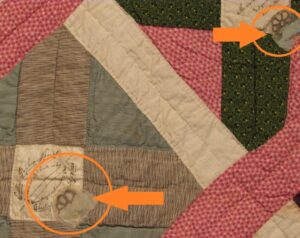 I’m going to start with the most unusual of the quilts. Some of my A-to-Z visitors may be aware of the Victorian tradition of saving hair of loved ones. Usually the created mementos were things like hair wreaths or hair jewelry (rings, etc). In this case, Eliza Burt Walton of Chesterfield, New Hampshire attached netting holding coils of hair to the quilt. The center block is inscribed “This album is composed of tokens of remembrance from old friends, associates and school mates in Chesterfield, New Hampshire, October 1854”
I’m going to start with the most unusual of the quilts. Some of my A-to-Z visitors may be aware of the Victorian tradition of saving hair of loved ones. Usually the created mementos were things like hair wreaths or hair jewelry (rings, etc). In this case, Eliza Burt Walton of Chesterfield, New Hampshire attached netting holding coils of hair to the quilt. The center block is inscribed “This album is composed of tokens of remembrance from old friends, associates and school mates in Chesterfield, New Hampshire, October 1854”
The pieced blocks all bear names and are set on point. I love the square edges creating a diamond-like fringe.
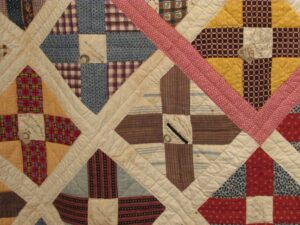
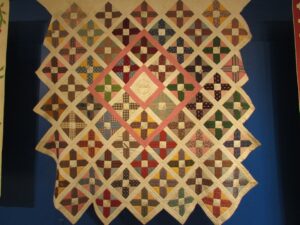
This first quilt was an Album quilt. This is when each of the blocks is a unique design. I took pictures of two more album quits. The first is a 1862 applique quilt, where red squares are in the corner of the sashing between the blocks. The second was created in 1846 by Esther S. White of Lancaster County, Pennsylvania. She was a Quaker. I love the green sawtooth boarder and the symmetry of the motifs.
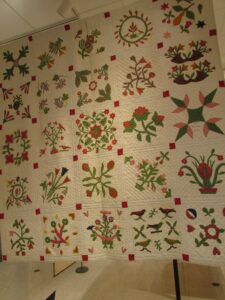
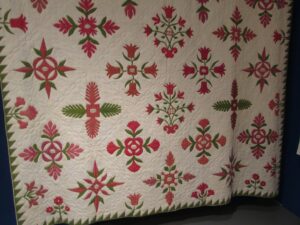
I did several up-close looks at the stichwork. The ones marked with pencil and/or pen make me feel better about my skill set. (Yes, that really is pencil marks) — I also got a close-up of where four pieces of cloth come together.
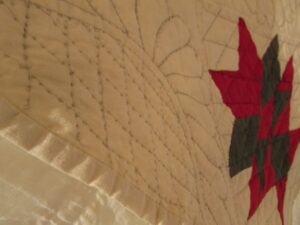
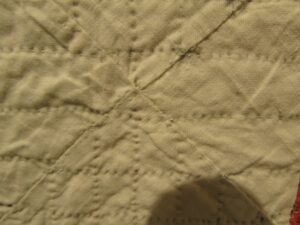
Two designs elements fascinated me: Princess Feathers and Double T. The name Princess Feather comes from the similarity of this motif with heraldry that honored the Prince of Wales and is a variation of “Prince’s Feather.” The circa 1860s quilt was created by (or for) Margaret Kearney from Auxvasse, Missouri. The Double-T pattern doesn’t have as rich a history, but the pattern is just as distinctive. The quilt was made for Elizabeth “Lizzie” P. Smith Heckard and her husband David Heckard, likely by Lizzie’s mother. (“Lizzie & David 1905” is quilted near one corner.) I personally would never attempt the Princess Feathers – I’ve done enough similar designs in applique and it is not easy, but the Double-T could be fun.
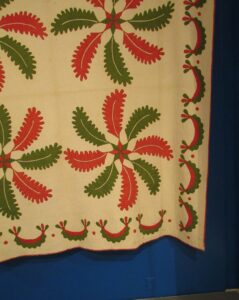
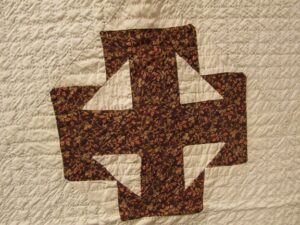
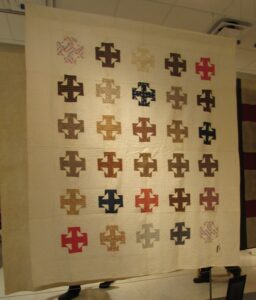
Several of the quilts are just out-and-out beautiful with their flowers. Below is a brown silk coverlet embroidered with the initials “E.B.” and the year “1836”, likely documenting the maker or who it was made for and the year the piece was completed. This exuberant summer spread of pinwheels and flower motifs has many eye dazzling details all sewn on an unusual dark background. And beside it is a Rose of Heaven appliqued quilt. The grape clusters are padded over and above the normal expected on quilts. The name associated with this quilt is Sara Dorliska Armsbury who either made this in Adams, Jefferson County, New York, or it was made for her. The rose wreath is a typical applique motif but the border of large grape leaves and small clusters of grapes is unique.
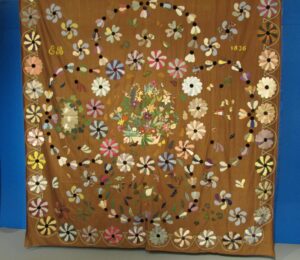
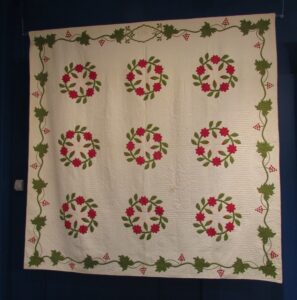
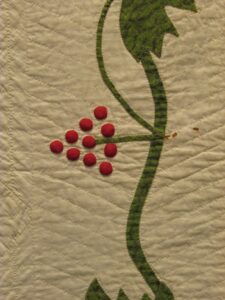
Next up is a medallion quilt. Like typical medallion quilts, this begins with a central pattern and builds out with borders.
The card beside the quilt read: The family history that come to the dealer with this quilt was that it was made by Eliza Woodfield Hagaman of Toms River, New Jersey beginning in 1874 with the October 16th birth of her daughter, Ellen Malsbury Hagman, and finished by the girl’s wedding in 1898. The website Find-a-Grave states that Ellen married Otis E. Hyers (1873-1960) in 1987. The bridal quilt gives many clues to when it was probably constructed. The fabrics as well as the use of a 3-ply thread and absence of any machine stitching suggest an earlier time period than the supposed 1874 start date. Eliza was born in Leicestershire, England and came to Pennsylvania about 1843 as a toddler. The England frame style construction suggest that the quilt could have been made by her mother, or her mother could have influenced the style Eliza chose. It is possible that Eliza began the quilt earlier than 1874, always planning to give it to her first-born daughter, who turned out to be Ellen.
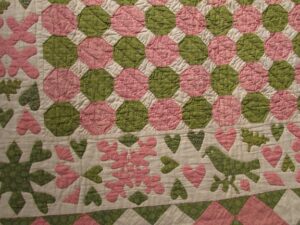
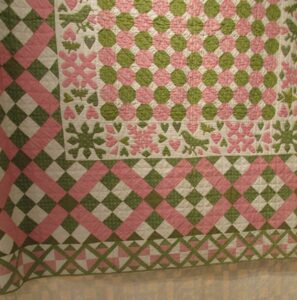
I also took pictures of another medallion quilt. In this case, the picture of the description card was not legible, so I don’t have details on this one. But seeing two versions of medallion quilts can help one get a feel for the design. You can see the herringbone design used in a border of one of the Album quilts; this time the design is red.
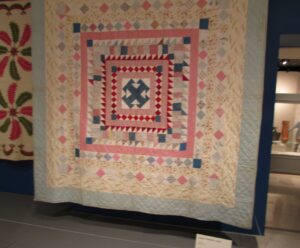
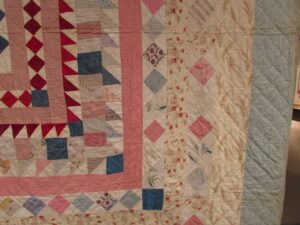
Last, but not least, especially to me, is a Hexagon quilt. Why this one is important to me is I inherited a hexagon quilt my grandmother made in New Mexico. Unlike these presentation quilts, that one was hard-used and I have been repairing it by replacing the damaged hexagons, appliqueing new pieces over the worn-out ones. Someday I will be done fixing it. When I do, I should post the results here.
Meanwhile this beautiful Hexagon red quilt is a great way to finish off the yesteryear blog. Take special note of the quilted border.
From the museum’s card: This striking red and white quilt was likely made via the technique known as English paper piecing where fabric is basted around a paper backing to create the hexagon shape. The border treatment is unusual for an English paper pieced quilt but solves the problem of how to handle the edges of a hexagon quilt. This border treatment is almost exclusively found on quilts made in Maryland. The use of this pattern – a hexagon – for inscribed names is rare, likely because the pattern is time consuming and there isn’t a lot of space to sign.
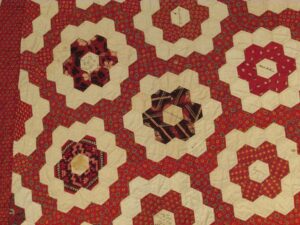
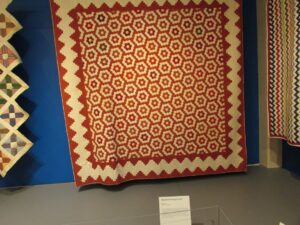
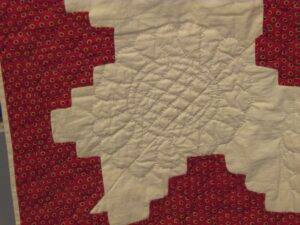
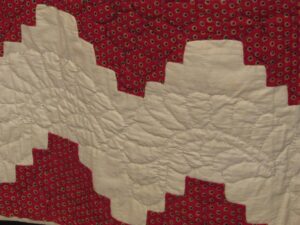
The beauty and the work of quilts is amazing.